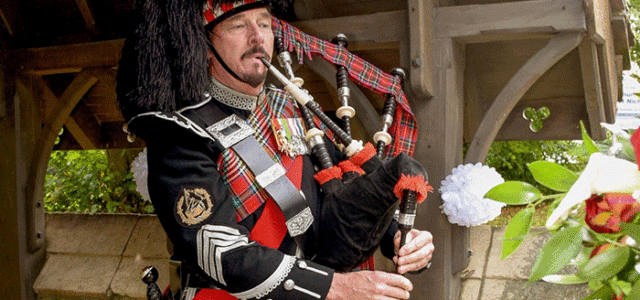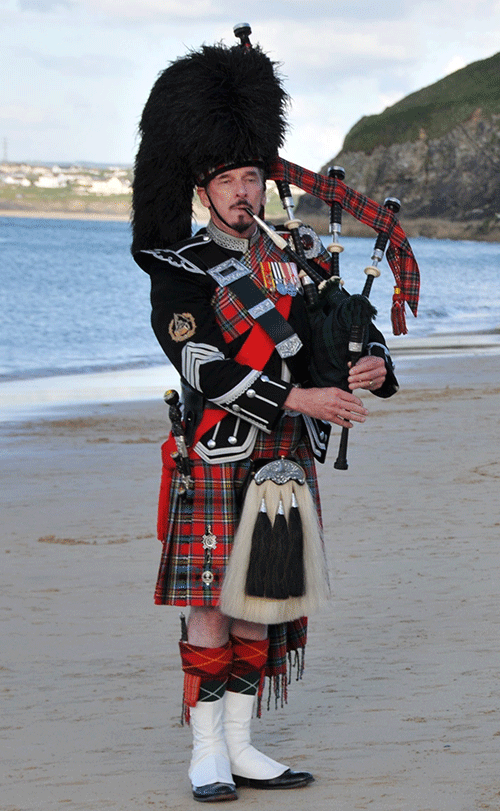
Having completed a thesis on tartan, worn a kilt from age six, being a current life member of the Scottish Tartans Authority and a member of the Incorporation of Weavers of Glasgow, and a piper from age seven, perhaps readers may understand why I feel qualified comment on Highland dress.
Much of what has been discussed so far in the pages of Piping Press falls squarely in the realms of tradition rather than hard and fast rules or regulations. There are many perfectly valid points of view as regards what is ‘right or wrong’ but it has to be folly to rely on so-called rules and regulations where they do not exist.
However, much of the current situation I feel, is down to a lack of knowledge of our history and traditions, so many of which are well worth preservation.
In the pipe band competition scene we have sadly lost the spectacular displays of pipers and drummers in full dress regalia, with the adoption of less expensive forms of uniform lacking the well-known traditions of wearing full dress.
Nevertheless, some of those traditions still apply to the adopted alternatives which can readily improve the appearance and smartness of any band. I recall being induced to play in the School Corps by my English literature master who was an ex-Captain in the Black Watch.
He had a fairly rigid view of how one wore a kilt and military garb. The kilt was not to touch the floor when one knelt down; it had to hang level all round and not droop at the back.
[wds id=”2″]
The hose should not be worn like football socks and should be set at a two-finger width below the tibial plateau (knuckle at the outside of the knee). Waist belt buckles should be centred on the body and not droop, and sporrans should not be worn either too high or too low.
Hair sporrans should just cover the bottom of the kilt apron. I realise that his view was from a military perspective, but I have remembered his advice and stuck to these principles ever since as, like most people, I needed guidance.
My early pipe band career in full dress, brought further principles in uniform wearing and I was well aware that the advice I had been given was for my education and uniformity of appearance.

The apparel that most bands wear today is still a uniform, and if individuals in any band do not get such guidelines as described above, they sadly remain ignorant of the accumulated traditions of our art and end up disrupting the look of what could be a well turned out polished band and a truly fine sight for anyone to see.
Smartness of a band or a solo piper is a distinct compliment to the music we make.
A recent post from a Breton piper asking about ‘rules and regulations’ highlighted some of the many misconceptions that have crept into general thinking.
He wanted advice on what is acceptable when wearing Highland dress in solo competition. The following was my offering in response: Flashes can be whatever you wish but good taste should be the byword and avoid clashing or garish colours.
There are very few restrictions on which tartan anyone can wear. One such is the Balmoral tartan, which is exclusively reserved for the Sovereign and her family with the Queen’s Piper included.
Some recent designs registered with the Scottish Tartan Register show a number which are copyrighted, but if you stick with an older sett, you should be fine.
An old tradition used to be that any subject of the British Crown is entitled to wear the Royal Stewart tartan, but there is no recognised basis for this.
Royal Regiments of the British Army have often worn Royal Stewart in homage to their ‘Royal’ status or membership of the Household Division.
As for an entitlement for Bretons to wear this tartan, this is a mystery to me and I know of no basis for this claim. Colouration of threads within any tartan is often the choice of the weaver or mill unless the design specification requires a distinct shade.
As a member of the Pipes & Drums of the 1st. Battalion Scots Guards, I can say that there is no rule or restriction about the shades of colours within the tartan we wear.
Whether to wear a Glengarry or a flat ‘Balmoral’ bonnet? Black balmorals come almost exclusively with a red tourie. In the old days, this was the finishing remnant of the knitted hats and would have been the same colour as the bonnet.
We no longer wear knitted headgear and the tourie (red or black) is only a residual feature of Scottish style head wear. To offer an answer to the last question, we move into the realms of taste and opinion.
There is an old saying ‘less is more’ and when it comes to having all accoutrements in tartan, one is in danger of looking rather like a tourist shortcake tin design.
If you wish to adorn your pipes with ribbons to match your kilt, then look to using a plain bag cover. But take a little advice from a veteran: when performing in solo piping competition, don’t use ribbons.
If the day happens to be windy, you would be in danger of the ribbons flapping over your drones and stopping them. That would not gain you any prestige or benefit! However, the choice is yours – just dress as smart as you can and take pride in it.
[wds id=”8″]
















I don’t mean to be rude Paul, but this is a perfect example of personal imposition of contrived rules and regulations that have no basis whatsoever, either factual or traditional.
A couple of other times re: Full Dress.
Duty sash is over over the waist belt
Generally the sporran strap is all leather – not chain
Scabbard and metal trim of sgian dubh should be under the hose, only handle showing.
Limit kilt pin to one or none.